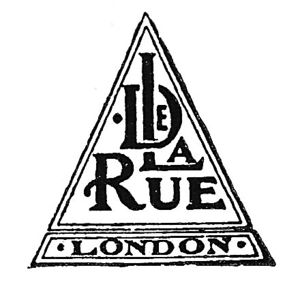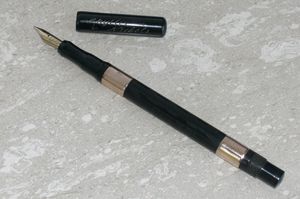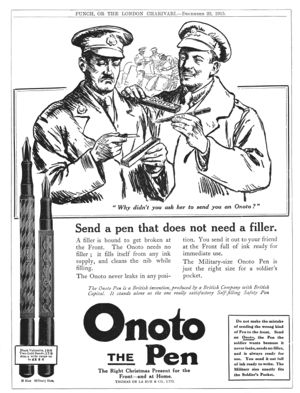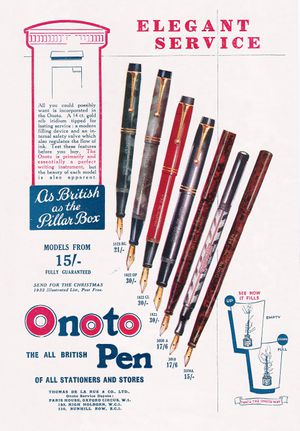Differenze tra le versioni di "Onoto/en"
(Creata pagina con 'thumb|left|[[Onoto models from a 1932 advertisement]]') |
|||
| Riga 37: | Riga 37: | ||
[[Image:1932-12-Onoto-Models.jpg|thumb|left|[[Onoto]] models from a 1932 advertisement]] | [[Image:1932-12-Onoto-Models.jpg|thumb|left|[[Onoto]] models from a 1932 advertisement]] | ||
| − | + | But the company most significant model was introduced in 1937, when [[Onoto]] launched the [[Magna]], a large pen like the previous [[Mammoth 1800|Mammoth]], with a two-color nib, the three rings ont the cap, produced in a new translucent celluloid created with a very complex process, in the black chiseled, green/brown and silver/gold colors. These pens were joined by other smaller models called [[Minor]] and [[Dainty]]. WWII however weighed negatively on the diffusion of the new pen, with the production that was soon converted to armaments to support the war effort. | |
[[Image:File:Onoto-Magna-WB-Posted.jpg|thumb|Una [[Onoto]] [[Magna]]]] | [[Image:File:Onoto-Magna-WB-Posted.jpg|thumb|Una [[Onoto]] [[Magna]]]] | ||
Versione delle 19:54, 1 apr 2012
Onoto - De La Rue origin dates back to 1813, although the real start of fountain pen production dates back only at the beginning of last century. The company, however, was already operating in the 1800s in the field of writing instruments and it is the oldest British manufacturer of fountain pens. His fortune, however, stem from another activity, the production of playing cards, which led to even greater success when they entered, taking advantage of the technologies acquired for cards, in the production of paper money, in which the company is still operating.
Onoto - De La Rue entered in the fountain pen history for the creation in 1905 of the first plunger filler model, introducing an automatic filling system that was functional and efficient even when all other brands, except Conklin, were substantially tied to the use of the eyedropper. Apart from the initial period, the company maintained a very conservative attitude, beeing a late follower for new stylistic tendencies. Fountain pen production was also a peripheral activity for the The De La Rue Company. Despite this, theirs pens were of the highest quality and are still highly sought and prized by collectors. After the advent of the ballpoint pen, production was discontinued in the late '50s, to be resumed, as for many other historic brands, in recent times.
| Onoto |
|---|
| Brand pages |
| Brand advertising |
| Brand photos |
| Instructions sheet |
| Patents |
History
The De La Rue activities were started in 1813 by Thomas De la Rue in Guernsey in France, with the printing of the newspaper Le Miroir Politique. Three years later Thomas De la Rue moved to England and since 1821 began to operate as a printer in the manufacture of office equipment. The initial success of the company is however due to the creation of an efficient method for printing playing cards (up to then hand-painted) that constituted the early fortunes of the company, and its reputation as the creator of English playing card.

But the real success came entering the market for the stamps and paper money production, which occurred with the experience gained in the production of playing cards. This made the company one of the most important British industries. Although commercial success has taken place much later, De La Rue presence in the writing objects market dates from the late '800, when, in 1881, they introduced the Anti-Stylograph pen , a first model of fountain pen, albeit primitive. Following other models were produced, as the Swift of 1884, distributed for more than 10 years, or the Pelican of 1895, another pen with a reservoir, and further models always having a tank valve, such as the Onostyle or the Umpire.
But the first modern fountain pen produced by the De La Rue was born in 1905. At that time Evelyn Andros De La Rue, great-grandson of the founder, who had a passion for inventions, was striving to build a fountain pen that was actually functional, and had already filed several patents for a primitive plunger filler.[1] But his pen was defective and required to be loaded a repeated pressure of the piston, whith a complex mechanism. During the same period George Sweetser made a pen based on the same principle but with an improved mechanism,[2] substantially identical to the present one. George Sweetser showed his invention to Evelyn De La Rue who bought it immediately, and managed to convince his father Thomas Andros De La Rue, who was in the board of directors, about the validity of the investment, so that in 1905 was started a fountain pen production.
The new pen was called simply Onoto. That name origin is uncertain and there are different theories. Some people date it back to Tokusaburo Ono, a Japanese watch manufacturer whose projects were used for the previous Onostyle pen, some others say it was chosen for its simplicity and because it is easy pronounced and with the same sound in many different languages. The financial strength of the company allowed a big launch of the new brand, and the new fountain pen was a huge success, so that in a short time was called: Onoto The Pen.

Earliest Onoto pen were made in black chased hard rubber, with overfeed nibs and produced in two sizes, the N and the O which later were called 3000 and 2000. The early models were produced in different colors and materials: to black chased hard rubber were added models in red/black marbled hard rubber, in red chased hard rubber, and also models overlay models in silver or gold, decorated with filigree or engine turned; their prices ranged from half to 5 guineas. The N model remained in production for over 30 years until 1939, with little changes apart from the replacement of the original overfeed nib with an ordinary one.
Given the pen success it was marketed also in France and in 1909 a branch was open in New York. But despite these fountain pen being much better from the technical point of view than the american competing models, the De La Rue did not make significant efforts to publicize its products in the high competitive U.S. market, not having a significant success. In the same year are cited some new models named Empire, Elfin and Express.
In 1911 De La Rue lost the state contract for the production of stamps and underwent an internal restructuring to become a limited liability company owned by Thomas Andros and his sons, in 1915, Evelyn De La Rue resigned and the company remained in the hands of his brother Andros Stuart who did not have a significant interest in the production of fountain pens. The company suffered a drop in sales, which led in 1921 to restructure itself as a limited company, with the property that was essentially sold to a consortium of three other major companies.

In those years however production continued without significant changes, the company had in fact a functional and efficient fountain pen, and saw no reason to make changes. However marbled hard rubber was introduced (1913?). In a 1913 catalog are cited the Hermit (a safety) and Pentago models, where the Valvless model is in 1915. The overfeed nib was replaced by an ordinary nib in 1921, when it was also introduced the Ink Pencil, a plunger filler stylographic model.
In the '20s there were several innovations, hounded by competition Onoto began to produce lever filler models, the 7000 and 8000. The introduction date of these models is uncertain and various sources report either the 1922, 1923 or 1924.[3] In 1924 was also produced the Mammoth 1800 model, a pen with a large number 8 nib, and the following year the Princess Mary a model made in blue colored hard rubber. The company continued to resist the trends and innovations, as well as the introduction of celluloid is quite late; even in this case are given different dates,[4] the 1926 or 1928.
In 1927 production was moved to Strathendry, Scotland, in the Leslie village in Fifeshire, Lambrou cites the move as a counter to the claims brought forward by the unions at the site of Burnhill Row in London. The move included the dismissal of all those who not wanted to transfer, but not proved very effective because of the presence of a dismissed at the shareholders meeting, which brought in around a month all transferred employees to apply for membership to trade unions. On the company website you will find a different story, in which thirty of the most capable workers agreed to move from London, with the company that took charge of finding them a home.
In the '30s the company continued doing its production from Strathendry, which began in 1928 with the De La Rue Pen model, a celluloid pen, made in different colors like black, blue marbled, green and red. There were also produced lower price pens as the Swift and Everybody's Pen. In 1935, following the trend introduced by Vacumatic for transparent pens that lets you view the ink level, Onoto the introduced Visible-ink model.

But the company most significant model was introduced in 1937, when Onoto launched the Magna, a large pen like the previous Mammoth, with a two-color nib, the three rings ont the cap, produced in a new translucent celluloid created with a very complex process, in the black chiseled, green/brown and silver/gold colors. These pens were joined by other smaller models called Minor and Dainty. WWII however weighed negatively on the diffusion of the new pen, with the production that was soon converted to armaments to support the war effort.
La produzione riprese a pieno ritmo nel dopoguerra solo a partire dal 1947 con la reintroduzione di una nuova serie di Magna alcune delle quali dotate di caricamento a levetta. Vennero introdotte nello stesso periodo una nuova serie di penne color perla marmorizzato. Ormai però l'azienda aveva perduto ogni capacità innovativa, e continuò a produrre penne economiche con caricamento a levetta seguendo sostanzialmente le tendenze del mercato, con la Onoto Penmaster a pennino coperto e cappuccio metallico, entrando pure nel mercato delle penne a sfera.
Come per gli altri grandi produttori la concorrenza della penna a sfera usa e getta assestò un colpo mortale all'azienda, l'ultimo modello significativo prodotto fu la Onoto K del 1955, una penna con caricamento a stantuffo con pennino coperto e serbatoio visibile e cappuccio a incastro, prodotta in diverse versioni. Nel 1958 la produzione di penne da parte della De La Rue cessò definitivamente con la chiusura dello stabilimento di Strathendry avvenuta il 27 febbraio 1958. La produzione comunque proseguì per qualche anno, fino al 1963, in Australia dove la Norman Backer e la Longhurst Pty Ltd. che avevano curato la distribuzione delle Onoto per 32 anni rilevarono la produzione. Come molti altri marchi storici anche la Onoto è stata riportata alla luce in tempi recenti per la produzione di penne moderne.
Template:CronoMarche |- | 1813 || Thomas De la Rue inizia le sue attività a Guernsey |- | 1881 || Introdotta la Anti-Stylograph, una stilografica primitiva |- | 1905 || La De La Rue lancia la sua stilografica con il marchio Onoto |- | 1909 || Aperta una filiale a New York |- | 1913? || Introdotta l'ebanite rosso/nera mottled denominata Antique |- | 1915 || Introdotto il modello Valvless |- | 1921? || Introdotto un pennino ordinario al posto dell'iniziale dotato di alimentatore superiore |- | 1921 || Introdotto il modello Ink Pencil, una penna a stilo |- | 1922 || Introdotto il modello Receder con caricamento safety (o 1921?) |- | 1923 || Introdotti dei modelli con caricamento a levetta (o 1922 o 1924?). |- | 1924 || Introdotto il modello Mammout 1800 con pennino n. 8 |- | 1924 || Iniziata produzione di fascia inferiore senza marchio Onoto |- | 1925 || Introdotto il modello Princess Mary in ebanite colore blu |- | 1927 || La produzione viene spostata in Scozia, a Strathendry nel villaggio di Leslie nel Fifeshire. |- | 1928 || Introdotti i primi modelli in celluloide (o 1926?) |- | 1935 || Introdotti i modelli in celluloide trasparente visible ink |- | 1937 || Introdotti i modelli Magna, Minor e Dainty |- | 1955 || Introdotto il modello Onoto K |- | 1958 || Chiusura della produzione della Onoto in Inghilterra |- | 1963 || Chiusura della produzione della Onoto in Australia |- |}
Template:LegendaModelli |- | XX || 19XX || XX, ? |- |}
Note
- ↑ like the nº GB-190502671.
- ↑ George Sweetser registered patents nº GB-190513768 and nº GB-190704787.
- ↑ respectively [1], [2] and [3]; Andreas Lambrou speaks of a 1924 patent.
- ↑ respectively [4] gives the 1926 and [5], [6] and Andreas Lambrou the 1928.
Riferimenti esterni
- http://www.penmuseum.co.uk/master%2011.htm Articolo sulla storia della ditta, originante al 1955 circa di autore ignoto
- http://hubpages.com/hub/A-Brief-History-of-Onoto-Pens Altro articolo sulla storia dell'azienda
- http://en.wikipedia.org/wiki/De_La_Rue Pagina sulla De La Rue su Wikipedia
- http://www.vintagepens.com/Onoto.shtml Breve articolo sulle penne Onoto
- http://www.onoto.com/history.asp Sito ufficiale dell'azienda rifondata nel 2004, con varie informazioni storiche
- http://www.penmuseum.co.uk/master%203.htm Articolo sulla riparazione delle Onoto
- http://www.fountainpennetwork.com/forum/index.php?showtopic=113186 Una discussione con una testimonianza diretta
